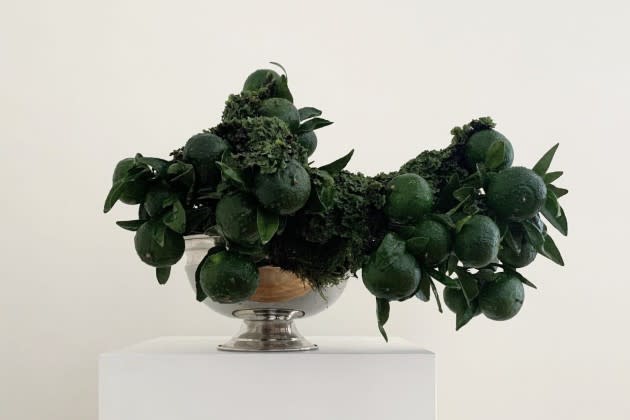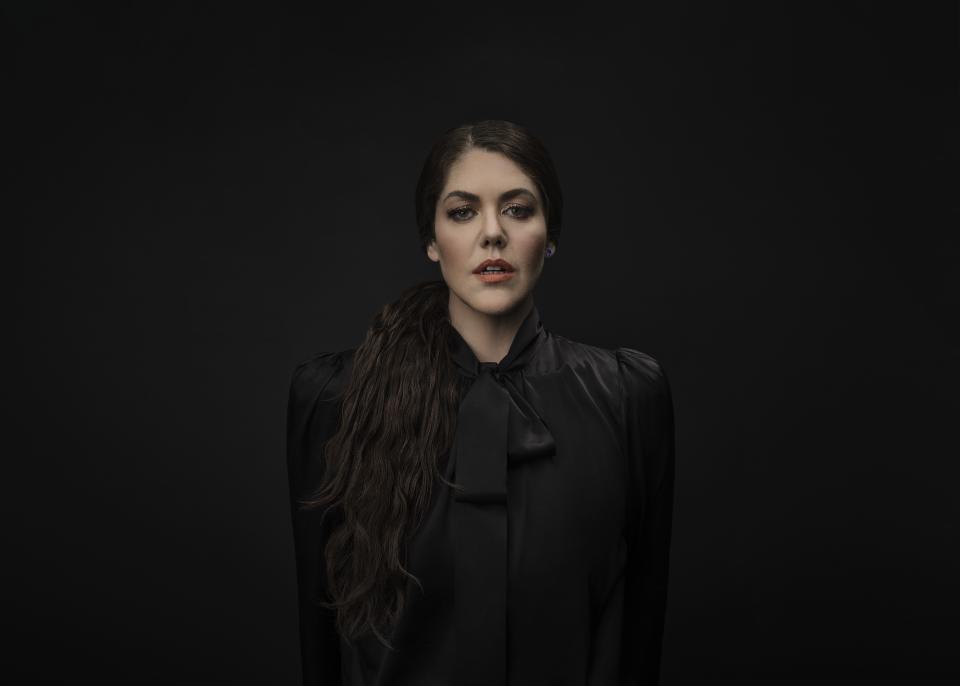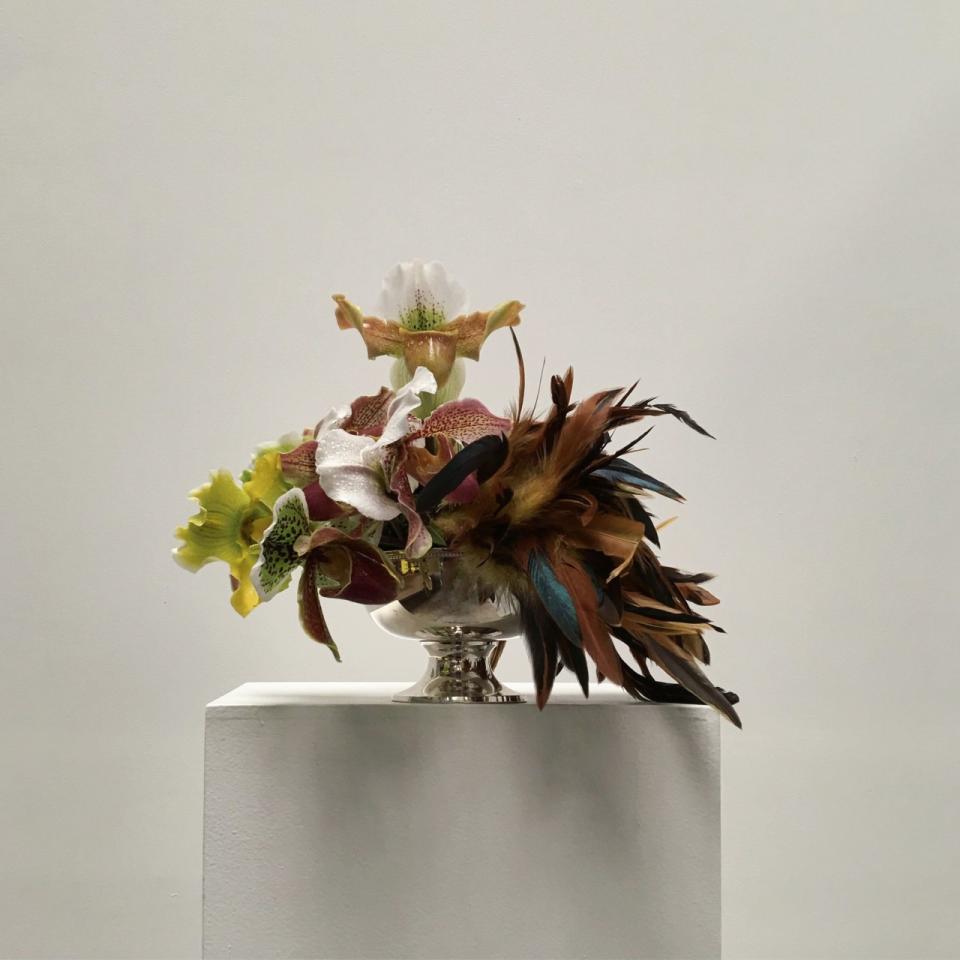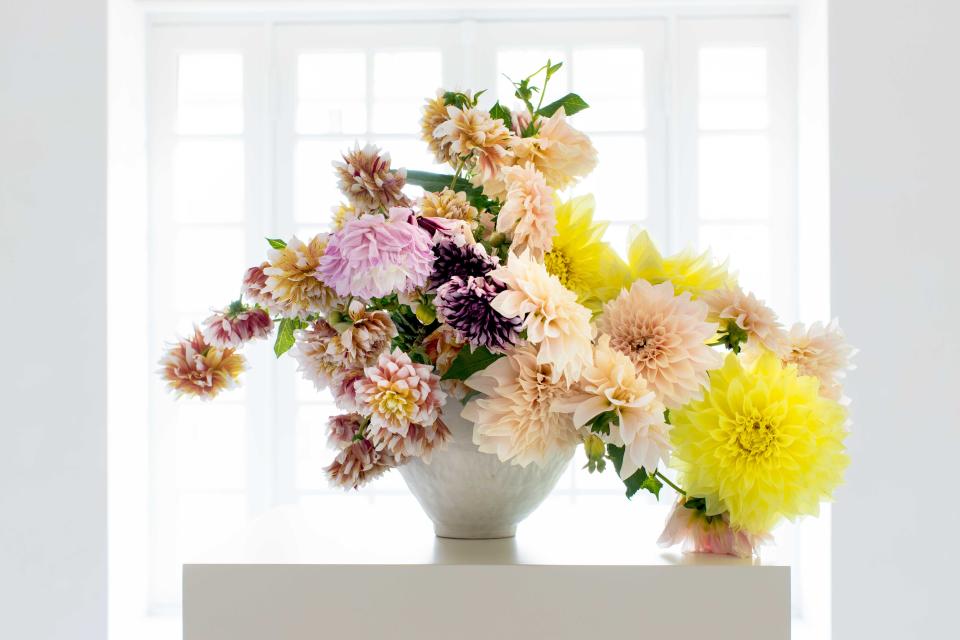Doctor Cooper Will See Your Flowers Now

No one tells artist, florist and doctor of philosophy Lisa Cooper how to do the flowers.
And despite her use of flowers, fruit and foliage in her work, don’t call her “floral artist,” a shortcut that makes her “cringe” and is “disrespectful to both [fields].”
More from WWD
Why? “I do everything a florist does, but my intention is different. To me, [compositions] are not pure whimsy,” explains Cooper, who holds a doctorate of philosophy in fine art from the College of Fine Arts of the University of New South Wales, calling flowers “some of the most powerful symbols we have.”
Seeing flowers as sculptures, she “feels the weight of doing them justice and making sure that [the result] is an object and a feeling of absolute beauty.”

With influences as broad as mystic elements taken from her Catholic upbringing, artists that range from Marina Abramovic to Anish Kapoor and “every artwork [she] has ever taken in, voluntarily or not,” Cooper’s compositions are bold gestures that often seem to taunt gravity with their horizontal outlines.
The occasional feather or intricate cascade of velvet ribbon complete these compositions offered in a variety of vessels, from paper wrappings to silver bowls.
With such a striking mien, it’s little wonder fashion soon came to find the good doctor.
Though her compositions have since been commissioned by the likes of Hermès, Cartier, Chanel, Lancôme or Dior, the relationship with fashion, a field she did “not know much about,” started with a no.
“I could hear myself say ‘nobody tells me how to do the flowers, so no’ and I kept asking myself why I was that way,” she says with a laugh, recalling how a brand had come wanting to impose flowers and concepts. Months later, Cooper received a call from the same brand — and a carte blanche.
As ethereal as she can seem at times, don’t expect any childhood recollections of running through hazy flower-strewn fields.
Her childhood was spent in Manly, a seaside suburb of Sydney, Australia, best known for its beaches and surfing spots.
“My first memory of flowers is actually stealing a red rose [from a neighboring garden] and then a man came out and he was so angry. I must have picked his pride and joy,” she says, recalling how her father had sent her to present a watermelon as a gesture of apology.

While there was no fairy godmother to preside over her cradle, Cooper felt a touch of predestination in her floral calling. Over her childhood bed, her grandmother hung a portrait of Saint Thérèse of Lisieux.
“This woman who had been looking over me the whole time was the patron saint of florists and those who have lost parents,” she muses, recalling the gilded oval frame that had once belonged to her great-grandmother.
She credits her father, a larger-than-life 6 foot, 1 inch man who “had all the spirit of artist in the body of a butcher” and whose mother was a painter, for her to flowers.
Diagnosed with an aggressive cancer and given six months to live when Cooper was six years old “exaggerated his philosophical vision,” lead him to talk about “how what he did in butchery was akin to sculpture,” using rules of composition to back his reasoning, she recalls of her father.
Though he outlived his initial diagnosis, Cooper’s father passed away when she was 13 years old, a seminal moment where “the house filled with flowers” that felt like his final message.
“I always had an odd way of thinking that he helped along,” she says. “I could recognize their grace, the grace of what had happened to him inside the pain of it.”
Cooper spent her undergraduate years exploring painting to “understand the medium before color, outside of color,” soon realizing that what [she] was doing with the paint was more about building up the material and being outside of and beyond the canvas.”
After an undergraduate degree in sculpture, she broadened her studies to include performance and installation. A master’s degree followed, as did a Ph.D., ”the greatest indulgence of [her] life” that forced her to “relinquish everything in order to get it done,” including her marriage.
That’s when the flowers reappeared and Cooper became “Dr. Lisa Cooper.”
To support herself through her thesis that broadly explored the annihilation of the self in video portraiture; the intermediation between the divine and humans, and “posited prayer as a metaphor for art practice,” she began working at Grandiflora, a famous Sydney-based florist.
Working there made her realize that she ”had mastery over [the flowers] but they also had mastery over me, so together we could image human emotions, love — that was all I ever wanted to do,” she explains, visibly moved.

Fellow artists were the first to come knocking when she opened her flower business to make her “flower gestures” commercially available. Prominent Australian galleries came to her to interpret the works of other artists.
The Sydney Theatre Company, then under the direction of the husband-and-wife duo of director and playwright Andrew Upton and actress Cate Blanchett, likewise called on her.
Her academic process also helped her articulate her thoughts fully. Early school years had been difficult, but academia taught Cooper to use her thoughts for power.
If she describes her writing as “a bit elliptical and difficult,” the captions she today regales the 72,000 followers of @doctorcopper with swing between the laconic and the poetic, with a dash of breezy elegance.
“Flowers for whiskey,” read one, while another gushes “my darling, darling, darling, astonishing (the whole wide world).”
Nowadays, Cooper’s artistic practice is looming larger than commercial pursuits, seeing her become the first permanent resident at The Mint, a residence within the Sydney Living Museums, and artist-in-residence in the city’s Hermès store.
And her influence has extended in unexpected ways.
In 2015, she published a book, simply titled, “The Flowers,” with Australian publisher Murdoch Books. Sold at Colette, this showcase of her work was “a revelation” for Louis-Géraud Castor, then an art dealer, leading him to quit his job and open the Castor Fleuriste floral studio, a firm favorite of the fashion set.
Likewise, Cooper discovered what she calls a “kindred spirit” in him when Just An Idea founder Sarah Andelman proposed she write the foreword for the book on Castor published in 2021.
She did, and Castor then returned the favor for the tome on Cooper published in October and was the one who facilitated the ensuing exhibition at the Icicle flagship store in Paris, lending her a hand — and the Mathilde Martin stoneware vase that was the first item he purchased in his new career.

Even so, Cooper is adamant that no one else touch her work until she is good and done.
The penultimate step in the moment a composition is done is once she has “fallen absolutely in love with the flowers and put them in my heart,” she says. After that, at “the height of [her] love for them,” Cooper documents them. And “then I don’t own them anymore,” she says.
Letting go is the final, and perhaps most important, step of the process. A conversation with an astrophysician-turned-blacksmith confronted her with “the enormity of time“ and the place of decay in her work.
His conclusion that “nothing in the universe is forever,” she says, left her profoundly saddened at first, but a night of reflection led her to think that “there is one thing that does: love, an energy that just keeps moving.”
“There are so many things that we hold onto that never get to our soul. Flowers’ aspect of passing and projecting mean that we can’t hang [their beauty] on the wall, hold it or wear it on our fingers. We are forced to swallow it whole,” she says.
“The flowers will only exist in the heart and by extension, the soul,” she continues, calling it “the most beautiful place they can exist.”
So the more ephemeral, the better and the more precious.
“Death will come,” she wrote in the introduction of her Just An Idea volume. “But until it does, I will make a study of light.”
Best of WWD


